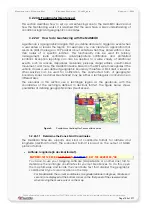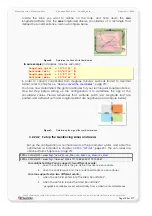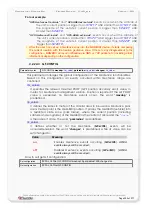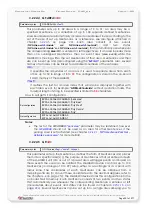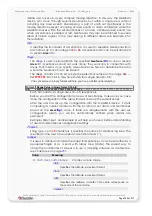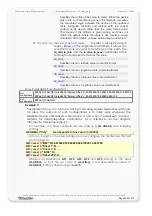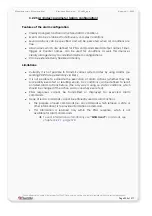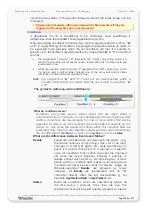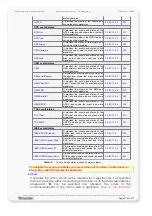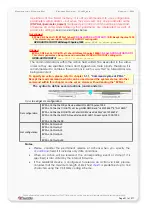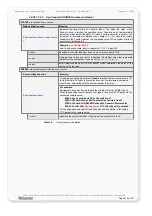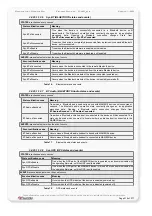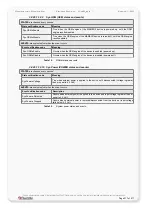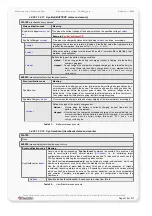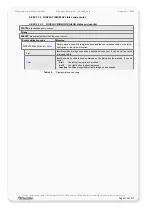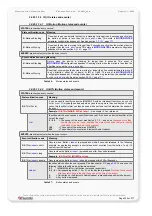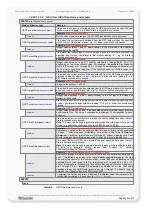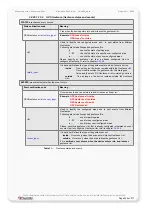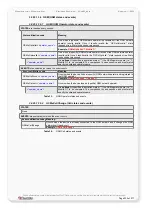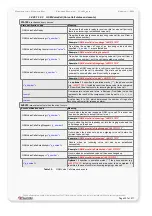
C
ONFIGURATION
C
OMMAND
S
ET
- F
IRMWARE
R
EVISION
2.4.0_
BETA
-
V
ERSION
1.0.0
3.2.25.1.1 Supported System Events and States
Internal firmware responds to device changes such as device has started ringing,
shutting down, a Button has been pressed, the system has received a specific string
from the server or the system has been connected/disconnected to/from the server by
firing device events. An application should respond to a device event by querying for
the specific change that has occurred and then executing appropriate action(s).
Many device events occur in conjunction with executed action(s).
For example:
AL0=
IO.BTN.e0=long
:Sys.Device.Sleep=IGN+Ring
(
whenever the Button 0 (BTN0) is
pressed for longer than 2 seconds, the system goes to sleep. Once this action is
executed the system releases the
Sys.Device.eShutdown
event)
All condition types
<c_type>
and their definition using the
Firmware version 2.4.xx or
later are listed below
. Each of them is used to separate the huge amount of conditions
to different types. Depending on the alarm configuration inside the
field,
the following states and events can be set:
1.
Sys
- (System) accomplishes a number of system states and events such as:
System management tasks, including:
Reset, Shutdown, Power management etc.
Initialization/interruption of system processes, including:
Timers, Counters, etc.
2.
IO
accomplishes a number of input events including Button events, which can raise when
one of them is pressed (based on the press-time)
3.
GPS
- accomplishes a number of GPS events including navigation, history logging and
Geofencing data, which can be occurred during MAMBOII operation.
4.
GSM -
accomplishes a number of GSM events, including SMS, voice and data calls,
GPRS attachment/detachment, etc., which can be occurred during MAMBOII operation.
5.
TCP
- accomplishes a number of TCP events including connecting disconnection and
sending of TCP packets to the predefined address of remote server, etc, which can be
occurred during MAMBOII operation.
6.
IEEE
accomplishes a number of input events including IO events for IEEE external
devices ( I/O-BOX), which can raise when one of them changes its state.
3.2.25.1.1.1 Comparators used within Events/States
In some conditions the comparators listed in table below are used to compare, i.e.
the current speed of the device with a user specified value or the current state of
the device inputs etc.
Type of comparators
Operation
Example
=
equality
Sys.Timer.s0=running
!=
inequality
Sys.Counter.s0!=0
<
less-than
GSM.DataCalll.sRingCounter<2
>
greater-than
GPS.Nav.sSpeed>10
<=
less-than-or-equal-to
Sys.Counter.s0<=10
>=
greater-than-or-equal-to
Sys.Counter.s0>=10
Table 11:
The comparators list.
For most simple types, comparison is straightforward. For example,
Sys.Timer.s0=running
is True just in case the
Sys.Timer.s0
is
running
and stays True
until the Timer 0 changes its state. The following rule applies to comparators.
No string values (supported by the firmware) can be compared by using the comparators
<, >, <=, >=
, and
!=
. In such cases use only the comparator
=
.
Do not change the order of comparators (<= and >=).
This confidential document is a property of FALCOM and may not be copied or circulated without previous permission.
Page 212 of 271

